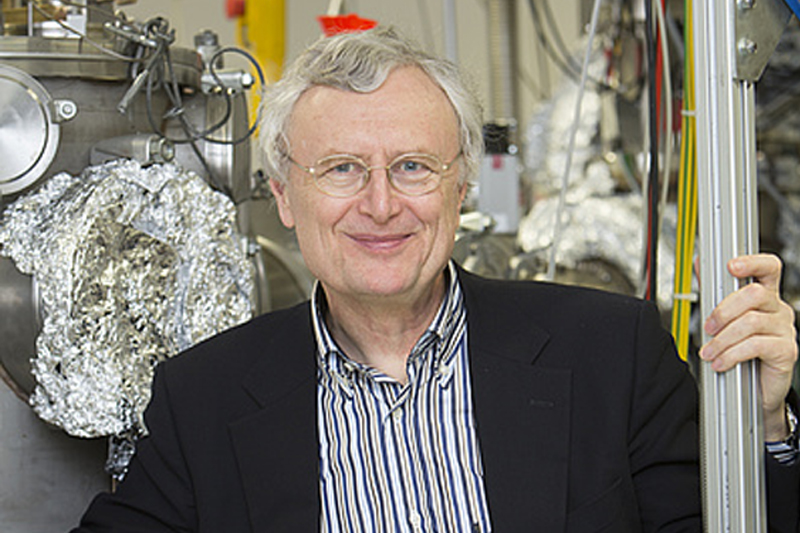
Professor Wolfgang E. Ernst from Institute of Experimental Physics, Graz University of Technology, Graz, Austria will give a lecture at Peter the Great St.Petersburg Polytechnic University on 29 June. The theme of lecture is: Molecular Dynamics and Cluster Formation in Superfluid Helium Droplets".
Abstract
The unique experimental conditions provided by helium nanodroplets (HeN) are not only utilized in a special form of matrix isolation spectroscopy [1] but are also interesting for the study of molecular collisions in a superfluid solvent. Superfluid droplets of 104 to 107 helium atoms (HeN) are doped with foreign atoms or molecules that move freely in or on the droplets and may form complexes in this cold environment.
In this way, alkali and alkaline earth metal atoms that stay at the droplet surface were observed to react and form mixed diatomic molecules that were spectroscopically investigated over the whole visible spectrum [e.g. 2, 3]. Our own quantum chemical calculations supported these studies providing valuable information about this class of molecules that may also be produced from ultracold atoms in traps.
In case of cluster formation inside HeN, it was long believed that all species that are collected inside a droplet, will immediately coagulate and form a stable aggregate in the cold environment. Unfortunately, depending on the dopant-helium interaction, a helium barrier may keep the atoms or molecules separated [e.g. 4]. In a first attempt to model aggregation, we recently derived collision times for the coinage metal atoms Cu, Ag and Au in He-droplets [5] by applying helium density functional theory and molecular dynamics simulations.
Larger Cu, Ag, Au, and Ni aggregates of different morphology are generated in helium droplets [e.g. 6] and their landing on a solid substrate was modelled in a molecular dynamics simulation [7]. Nanowires and core-shell clusters with one metal surrounding a core of different kind were observed, deposited on solid substrates [8, 9], and analyzed by high resolution electron microscopy and tomography [10]. As it turns out, the temperature of the substrate [9] and the doping rate [11] have an important influence on the final cluster or wire structure. Our systematic studies will help to provide recipes for the creation of tailored nanoparticles.
A brief survey will be given on other projects in my group addressing electron-nuclear coupling phenomena in molecules and semimetals.
[1] C. Callegari and W. E. Ernst, in: Handbook of High Resolution Spectroscopy, Eds. F. Merkt and M. Quack, 1st Edition, Vol. 3, 1551-1594 (2011).
[2] F. Lackner, G. Krois, T. Buchsteiner, J. V. Pototschnig, and W. E. Ernst, Helium Droplet Assisted Preparation of Cold RbSr Molecules, PRL113, 153001 (2014), http://dx.doi.org/10.1103/PhysRevLett.113.153001.
[3] J. V. Pototschnig, G. Krois, F. Lackner, and W. E. Ernst, Investigation of the RbCa Molecule: Experiment and Theory, J. Mol. Spectrosc. 310, 126-134 (2015) http://dx.doi.org/10.1016/j.jms.2015.01.006.
[4] A. Kautsch, M. Koch, and W. E. Ernst, Photoinduced Molecular Dissociation and Photoinduced Recombination Mediated by Superfluid Helium Nanodroplets, PCCP17, 12310-12316 (2015), http://dx.doi.org/10.1039/c5cp01009h .
[5] A. W. Hauser, A. Volk, P. Thaler and W. E. Ernst, Atomic collisions in superfluid helium-nanodroplets: Timescales for metal-cluster formation derived from He-density functional theory, PCCP17, 10805-10812 (2015), http://dx.doi.org/10.1039/c5cp01110h.
[6] P. Thaler, A. Volk, D. Knez, F. Lackner, J. Steurer, M. Schnedlitz, and W. E. Ernst, Synthesis of Nanoparticles in Helium Droplets - a Characterization Comparing Mass-Spectra and Electron Microscopy Data, J. Chem. Phys.143, 134201-1-10 (2015), http://dx.doi.org/10.1063/1.4932182 .
[7] P. Thaler, A. Volk, M. Ratschek, M. Koch, and W. E. Ernst, Molecular dynamics simulation of the deposition process of cold Ag-clusters under different landing conditions, J. Chem. Phys.140, 044326-1-9 (2014), http://dx.doi.org/10.1063/1.4862917 .
[8] P. Thaler, A. Volk, F. Lackner, J. Steurer, D. Knez, W. Grogger, F. Hofer, and W. E. Ernst, Formation of core-shell nanowires along vortices in superfluid He nanodroplets, Phys. Rev. B 90, 155442-1-5 (2014) http://link.aps.org/doi/10.1103/PhysRevB.90.155442.
[9] A. Volk, D. Knez, P. Thaler, A. W. Hauser, W. Grogger, F. Hofer and W. E. Ernst, Thermal instabilities and Rayleigh breakup of ultrathin silver nanowires grown in helium nanodroplets, PCCP17, 24570-24575 (2015), http://dx.doi.org/10.1039/C5CP04696C.
[10] G. Haberfehlner, P. Thaler, D. Knez, A. Volk, F. Hofer, W. E. Ernst, G. Kothleitner, Formation of bimetallic clusters in superfluid helium nanodroplets analyzed by atomic resolution electron tomography, Nature Communications 6, 8779-1-6 (2015), http://www.nature.com/ncomms/2015/151028/ncomms9779/full/ncomms9779.html .
[11] A. Volk, P. Thaler, D. Knez, A. W. Hauser, J. Steurer, W. Grogger, F. Hofer, and W. E. Ernst, The impact of doping rates on the morphology of silver and gold nanowires grown in helium nanodroplets, PCCP 18, 1451-1459 (2016), http://dx.doi.org/10.1039/C5CP06248A

